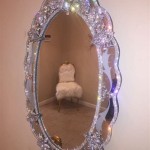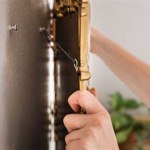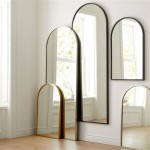The Allure and Practicality of Two-Way Mirror Bathrooms
Two-way mirrors, also known as one-way mirrors, present a unique and intriguing design element. They offer a perceived asymmetry in visibility, appearing as a standard mirror from one side while functioning as a window from the other. This characteristic offers distinct advantages and considerations, particularly in the context of bathroom design. Understanding the principles behind their function, the specific applications within bathrooms, and the ethical implications is paramount before incorporating them into a residential or commercial space.
A two-way mirror is constructed with a thin, semi-transparent coating of metal, typically aluminum, applied to one side of a glass pane. This coating allows a percentage of light to pass through the glass while reflecting the remaining percentage. The perceived “one-way” effect is achieved by manipulating the lighting conditions on either side of the mirror. The observation side needs to be dimly lit, while the mirrored side is brightly lit. This difference in light intensity causes the brighter side to be reflected, creating the appearance of a standard mirror. Conversely, the observer on the dimly lit side perceives the light filtering through the coating, allowing them to see through the glass as if it were a window.
The functionality of a two-way mirror is directly tied to the ratio of light on each side. If the light levels are approximately equal, the transparency effect diminishes, and both sides might perceive a faint reflection overlaid onto the view through the glass. Maintaining a significant difference in light intensity is crucial for the effective operation of the mirror.
Enhanced Privacy and Security
One of the primary reasons to consider a two-way mirror in a bathroom is for increased privacy. In situations where a bathroom shares a wall with a more public space, such as a hallway or a waiting area in a spa or salon, a two-way mirror can offer a sense of seclusion without completely isolating the space. From within the bathroom, the occupant perceives a standard mirror, while from the adjacent room, the mirror appears opaque. This configuration can be particularly beneficial in commercial settings where monitoring the bathroom for maintenance or security purposes is required, without compromising the privacy of the user.
Furthermore, the potential for covert surveillance is a factor to consider. While often used for legitimate security purposes, the presence of a two-way mirror should be explicitly disclosed to anyone using the bathroom to avoid any allegations of unethical observation. The responsible use of this technology is essential to ensure the privacy and comfort of individuals. Clear signage indicating the presence of a two-way mirror can mitigate potential concerns and promote transparency.
The integration of a two-way mirror can also contribute to the design aesthetic of a bathroom. By blurring the lines between spaces, it can create a sense of depth and openness. In smaller bathrooms, the illusion of a larger space can be achieved by strategically placing the mirror to reflect a hallway or other adjacent area. This design technique can make the bathroom feel less confined and more visually appealing. However, careful planning is necessary to ensure that the reflected area is aesthetically pleasing and does not introduce visual clutter.
Beyond privacy and security, the application of a two-way mirror extends to unique design choices. Integrating the mirror as part of a vanity unit or shower enclosure can contribute to a modern and minimalist aesthetic. Backlighting the mirror on the observation side can further enhance the illusion of depth and create a dramatic visual effect. The versatility of the material allows for customization and creative incorporation into various design schemes.
Considerations for Installation and Maintenance
The installation of a two-way mirror requires careful planning and execution. The supporting structure must be robust enough to handle the weight of the glass, and the lighting on both sides must be carefully controlled to achieve the desired effect. Consulting with a qualified contractor experienced in installing specialty glass is crucial to ensure a successful and safe installation. The contractor can assess the structural requirements, recommend appropriate framing materials, and advise on lighting placement to optimize the performance of the mirror.
Wiring for lighting should be concealed and protected to prevent electrical hazards. Consider using dimmable lighting on the observation side to allow for adjustments to the light intensity and further enhance the “one-way” effect. The wiring should adhere to local electrical codes and be inspected by a licensed electrician to ensure safety and compliance. Improper wiring can pose a significant risk of electrical shock and fire.
Maintenance of a two-way mirror is similar to that of a standard mirror. Regular cleaning with a glass cleaner and a soft cloth will help to remove fingerprints and smudges. Avoid using abrasive cleaners or scrubbing pads, as these can scratch the reflective coating. A mild solution of soap and water can also be used for cleaning, followed by a thorough rinsing and drying to prevent water spots. Routine inspections of the mirror and its surrounding frame can help identify any potential issues, such as loose screws or cracks in the glass, and allow for timely repairs.
Furthermore, it is crucial to protect the edges of the mirror from moisture and physical damage. Edges are often the most vulnerable part of the mirror and can be susceptible to chipping or delamination if exposed to excessive moisture or impact. Sealing the edges with a suitable sealant can help to prevent moisture penetration and prolong the lifespan of the mirror. In high-humidity environments, consider using mirrors with enhanced moisture resistance to minimize the risk of damage.
Ethical Implications and Transparency
The use of two-way mirrors raises several ethical concerns, primarily regarding privacy and consent. As previously mentioned, it is imperative to inform individuals when they are potentially being observed through a two-way mirror. Failure to do so can be construed as a violation of privacy and may have legal ramifications. Transparency and ethical considerations must be paramount in any decision to install and use a two-way mirror, particularly in sensitive environments like bathrooms and changing rooms.
Clear and conspicuous signage should be placed near the mirror, indicating its true nature and the possibility of observation. The signage should be easily visible and understandable, even to individuals with limited English proficiency. The language used should be direct and unambiguous, leaving no room for misinterpretation. The signage should also include contact information for someone who can address any questions or concerns about the use of the mirror.
In addition to signage, consider implementing other measures to promote transparency, such as a written policy outlining the purpose of the observation and the measures taken to protect privacy. This policy should be readily available to anyone who uses the bathroom and should be reviewed and updated regularly to ensure compliance with relevant laws and regulations. Regular audits of the observation system can also help to identify any potential privacy risks and ensure that the system is being used appropriately.
Finally, it is crucial to consider the potential for misuse of the two-way mirror. Access to the observation side should be restricted to authorized personnel only, and strict protocols should be in place to prevent unauthorized viewing or recording. Regular training should be provided to authorized personnel on the ethical and legal considerations associated with the use of two-way mirrors. These measures can help to minimize the risk of misuse and protect the privacy of individuals who are being observed.
In conclusion, the decision to incorporate a two-way mirror into a bathroom requires careful consideration of practical, aesthetic, and ethical factors. While these mirrors offer a degree of privacy, security, and design flexibility, open communication regarding their use is essential for maintaining a comfortable and ethical environment. Balancing the benefits with the responsibility is fundamental to the responsible implementation of this technology.

Acrylic Pmma 2 Way See Thru Mirror 3 0mm Thickness

Woman S Tiktok Exposes Terrifying Bathroom Feature

Woman Discovers Two Way Mirror In Bar Bathroom The Owner Isn T Even A Little Bit Sorry About It

Pin On Techead

How To Detect A Two Way Hotel Mirror Tips Ensure Your Privacy

Bar Owner Defends Two Way Mirror In Women S Restroom After Comedian Exposes It Cbc News

A New Way To View London From Toilet

Woman Investigates After Noticing Strangely Placed Mirror In Restaurant Bathroom

Two Way Mirror Found In Bar S Bathroom Stall

Sleek And Modern Two Way Mirror Public Restroom








